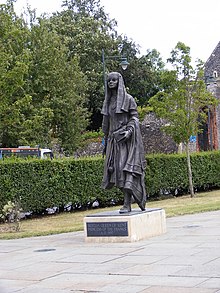Bertha of Kent
Bertha of Kent | |
|---|---|
 A statue of Queen Bertha in Lady Wootton's Gardens, Kent. | |
| Queen and Confessor | |
| Born | c. 565 Neustria, Francia |
| Died | In or after 601 Canterbury, Kent, England |
| Venerated in | Catholic Church Eastern Orthodox Church Anglican Communion |
| Canonized | Pre-Congregation |
| Feast | May, 1st |
| Bertha | |
|---|---|
| Queen consort of Kent | |
| Spouse | Æthelberht of Kent |
| Issue | Eadbald of Kent Æthelburg of Kent |
| Dynasty | Merovingian |
| Father | Charibert I |
| Mother | Ingoberga |
Saint Bertha or Saint Aldeberge (b. Estimated around c. 565 [1] – d. in or after 601) was the queen of Kent whose influence led to the Christianization of Anglo-Saxon England. She was canonized as a saint for her role in its establishment during that period of English history.
Life
Bertha was a Frankish princess, the daughter of Charibert I and his wife Ingoberga, granddaughter of the reigning King Chlothar I and great-granddaughter of Clovis I and Saint Clotilde .[2] Her father died in 567, her mother in 589. Bertha had been raised near Tours.[3] Her marriage to pagan King Æthelberht of Kent was conditioned on her being allowed to practice her religion.[4] She brought her chaplain, Liudhard, with her to England.[5] Bertha restored a Christian church in Canterbury, which dated from Roman times, dedicating it to Saint Martin of Tours. It was the private chapel of Queen Bertha before Augustine arrived from Rome. The present St Martin's at Canterbury continues in the same building as the oldest church in the English-speaking world and is part of the Canterbury World Heritage site.[6]
Augustine of Canterbury, whose Gregorian mission was sent by Pope Gregory I to preach the Gospel in England in 596, owed much of his favorable reception to the influence of Bertha.[7] Without her support, monastic settlements and the cathedral would likely have developed elsewhere.[8] In 601, Pope Gregory addressed a letter to Bertha, in which he complimented her highly on her faith and knowledge of letters.[4]
Anglo-Saxon records indicate that Saint Bertha had two children: Eadbald of Kent, and Æthelburg of Kent. She is named in the genealogies of various of the medieval accounts of the 'Kentish Royal Legend'.[9]
The date of her death is disputed.[4]
Legacy
The city of Canterbury celebrates Queen Bertha in many ways.
- The Bertha trail, consisting of 14 bronze plaques set in pavements, runs from the Buttermarket to St Martin's church via Lady Wootton's Green.
- In 2006 bronze statues of Bertha and Ethelbert were installed on Lady Wootton's Green as part of the Canterbury Commemoration Society's "Ethelbert and Bertha" project.[10]
- There is a wooden statue of Bertha inside St Martin's church.[8]
|
|
References
- ^ Janet L. Nelson, ‘Bertha (b. c.565, d. in or after 601)’, Oxford Dictionary of National Biography, Oxford University Press, 2004; online edn, May 2006 accessed 19 May 2015
- ^ Gregory of Tours (539-594), History of the Franks, Book 4 at fordham.edu
- ^ Taylor, Martin. The Cradle of English Christianity Archived March 24, 2013, at the Wayback Machine
- ^ a b c Wace, Henry and Piercy, William C., "Bertha, wife of Ethelbert, king of Kent", Dictionary of Christian Biography and Literature to the End of the sixth Century, Hendrickson Publishers, Inc. ISBN 1-56563-460-8
- ^ Bede, Ecclesiastical History
- ^ "Canterbury", World Heritage Site Archived May 24, 2013, at the Wayback Machine
- ^ Thurston, Herbert. "Bertha." The Catholic Encyclopedia. Vol. 2. New York: Robert Appleton Company, 1907. 7 May 2013
- ^ a b "Queen Bertha", Canterbury Historical and Archaeological Society
- ^ Rollason, D. W. (1982), The Mildrith Legend: A Study in Early Medieval Hagiography in England, Leicester: Leicester University Press, p. 45, ISBN 0-7185-1201-4
{{citation}}: Invalid|ref=harv(help) - ^ "6th Century royal statues on show", BBC News, 26 May 2006
External links
- 541 births
- 580 deaths
- Merovingian dynasty
- Anglo-Saxon royal consorts
- 6th-century English people
- 7th-century English people
- Women of medieval England
- Kentish saints
- Christian royal saints
- 7th-century Christian saints
- Gregorian mission
- Merovingian saints
- Christian female saints of the Middle Ages
- 6th-century women
- 7th-century women
- Frankish princesses



